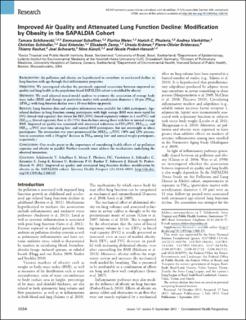Please use this identifier to cite or link to this item:
https://doi.org/10.21256/zhaw-3342Full metadata record
| DC Field | Value | Language |
|---|---|---|
| dc.contributor.author | Schikowski, Tamara | - |
| dc.contributor.author | Schaffner, Emmanuel | - |
| dc.contributor.author | Meier, Flurina | - |
| dc.contributor.author | Phuleria, Harish C. | - |
| dc.contributor.author | Vierkötter, Andrea | - |
| dc.contributor.author | Schindler, Christian | - |
| dc.contributor.author | Kriemler, Susi | - |
| dc.contributor.author | Zemp, Elisabeth | - |
| dc.contributor.author | Krämer, Ursula | - |
| dc.contributor.author | Bridevaux, Pierre-Olivier | - |
| dc.contributor.author | Rochat, Thierry | - |
| dc.contributor.author | Schwart, Joel | - |
| dc.contributor.author | Künzli, Nino | - |
| dc.contributor.author | Probst-Hensch, Nicole | - |
| dc.date.accessioned | 2019-03-29T08:19:59Z | - |
| dc.date.available | 2019-03-29T08:19:59Z | - |
| dc.date.issued | 2013 | - |
| dc.identifier.issn | 0091-6765 | de_CH |
| dc.identifier.issn | 1552-9924 | de_CH |
| dc.identifier.uri | https://digitalcollection.zhaw.ch/handle/11475/16419 | - |
| dc.description | All documents published by EHP are in the public domain. PDF copies of published articles can be freely shared and distributed without permission from either EHP or the authors. | de_CH |
| dc.description.abstract | Background: Air pollution and obesity are hypothesized to contribute to accelerated decline in lung function with age through their inflammatory properties. Objective: We investigated whether the previously reported association between improved air quality and lung health in the population-based SAPALDIA cohort is modified by obesity. Methods: We used adjusted mixed-model analyses to estimate the association of average body mass index (BMI) and changes in particulate matter with aerodynamic diameter = 10 µm (PM10; ΔPM10) with lung function decline over a 10-year follow-up period. Results: Lung function data and complete information were available for 4,664 participants. Age-related declines in lung function among participants with high average BMI were more rapid for FVC (forced vital capacity), but slower for FEV1/FVC (forced expiratory volume in 1 sec/FVC) and FEF25-75 (forced expiratory flow at 25-75%) than declines among those with low or normal average BMI. Improved air quality was associated with attenuated reductions in FEV1/FVC, FEF25-75, and FEF25-75/FVC over time among low- and normal-BMI participants, but not overweight or obese participants. The attenuation was most pronounced for ΔFEF25-75/FVC (30% and 22% attenuation in association with a 10-µg/m3 decrease in PM10 among low- and normal-weight participants, respectively.) Conclusion: Our results point to the importance of considering health effects of air pollution exposure and obesity in parallel. Further research must address the mechanisms underlying the observed interaction. | de_CH |
| dc.language.iso | en | de_CH |
| dc.publisher | National Institute of Environmental Health Sciences | de_CH |
| dc.relation.ispartof | Environmental Health Perspectives | de_CH |
| dc.rights | Licence according to publishing contract | de_CH |
| dc.subject.ddc | 616: Innere Medizin und Krankheiten | de_CH |
| dc.title | Improved air quality and attenuated lung function decline : modification by obesity in the SAPALDIA cohort | de_CH |
| dc.type | Beitrag in wissenschaftlicher Zeitschrift | de_CH |
| dcterms.type | Text | de_CH |
| zhaw.departement | School of Management and Law | de_CH |
| zhaw.organisationalunit | Winterthurer Institut für Gesundheitsökonomie (WIG) | de_CH |
| dc.identifier.doi | 10.21256/zhaw-3342 | - |
| dc.identifier.doi | 10.1289/ehp.1206145 | de_CH |
| zhaw.funding.eu | No | de_CH |
| zhaw.issue | 9 | de_CH |
| zhaw.originated.zhaw | Yes | de_CH |
| zhaw.pages.end | 1039 | de_CH |
| zhaw.pages.start | 1034 | de_CH |
| zhaw.publication.status | publishedVersion | de_CH |
| zhaw.volume | 121 | de_CH |
| zhaw.publication.review | Peer review (Publikation) | de_CH |
| Appears in collections: | Publikationen School of Management and Law | |
Files in This Item:
| File | Description | Size | Format | |
|---|---|---|---|---|
| Improved Air Quality and Attenuated_SC 1.1_2013.pdf | 281.36 kB | Adobe PDF |  View/Open |
Show simple item record
Schikowski, T., Schaffner, E., Meier, F., Phuleria, H. C., Vierkötter, A., Schindler, C., Kriemler, S., Zemp, E., Krämer, U., Bridevaux, P.-O., Rochat, T., Schwart, J., Künzli, N., & Probst-Hensch, N. (2013). Improved air quality and attenuated lung function decline : modification by obesity in the SAPALDIA cohort. Environmental Health Perspectives, 121(9), 1034–1039. https://doi.org/10.21256/zhaw-3342
Schikowski, T. et al. (2013) ‘Improved air quality and attenuated lung function decline : modification by obesity in the SAPALDIA cohort’, Environmental Health Perspectives, 121(9), pp. 1034–1039. Available at: https://doi.org/10.21256/zhaw-3342.
T. Schikowski et al., “Improved air quality and attenuated lung function decline : modification by obesity in the SAPALDIA cohort,” Environmental Health Perspectives, vol. 121, no. 9, pp. 1034–1039, 2013, doi: 10.21256/zhaw-3342.
SCHIKOWSKI, Tamara, Emmanuel SCHAFFNER, Flurina MEIER, Harish C. PHULERIA, Andrea VIERKÖTTER, Christian SCHINDLER, Susi KRIEMLER, Elisabeth ZEMP, Ursula KRÄMER, Pierre-Olivier BRIDEVAUX, Thierry ROCHAT, Joel SCHWART, Nino KÜNZLI und Nicole PROBST-HENSCH, 2013. Improved air quality and attenuated lung function decline : modification by obesity in the SAPALDIA cohort. Environmental Health Perspectives. 2013. Bd. 121, Nr. 9, S. 1034–1039. DOI 10.21256/zhaw-3342
Schikowski, Tamara, Emmanuel Schaffner, Flurina Meier, Harish C. Phuleria, Andrea Vierkötter, Christian Schindler, Susi Kriemler, et al. 2013. “Improved Air Quality and Attenuated Lung Function Decline : Modification by Obesity in the SAPALDIA Cohort.” Environmental Health Perspectives 121 (9): 1034–39. https://doi.org/10.21256/zhaw-3342.
Schikowski, Tamara, et al. “Improved Air Quality and Attenuated Lung Function Decline : Modification by Obesity in the SAPALDIA Cohort.” Environmental Health Perspectives, vol. 121, no. 9, 2013, pp. 1034–39, https://doi.org/10.21256/zhaw-3342.
Items in DSpace are protected by copyright, with all rights reserved, unless otherwise indicated.